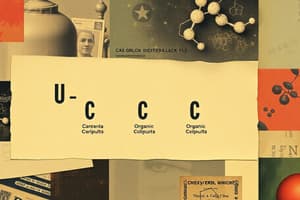Podcast
Questions and Answers
What is the primary bond that forms between monosaccharides to create disaccharides?
What is the primary bond that forms between monosaccharides to create disaccharides?
Which of the following is NOT a class of organic compound mentioned in biological contexts?
Which of the following is NOT a class of organic compound mentioned in biological contexts?
Which polysaccharide is primarily used for structural support in plant cell walls?
Which polysaccharide is primarily used for structural support in plant cell walls?
What level of organization do populations belong to in the biological hierarchy?
What level of organization do populations belong to in the biological hierarchy?
Signup and view all the answers
Which organelle is primarily responsible for energy transformations within a cell?
Which organelle is primarily responsible for energy transformations within a cell?
Signup and view all the answers
Which statement correctly describes the hierarchy of biological organization?
Which statement correctly describes the hierarchy of biological organization?
Signup and view all the answers
Which macromolecule is NOT classified within the context of biological importance?
Which macromolecule is NOT classified within the context of biological importance?
Signup and view all the answers
What type of biological community includes both living organisms and their nonliving environment?
What type of biological community includes both living organisms and their nonliving environment?
Signup and view all the answers
What type of bond joins monosaccharides together to form disaccharides and polysaccharides?
What type of bond joins monosaccharides together to form disaccharides and polysaccharides?
Signup and view all the answers
Which carbohydrate is primarily used as a metabolic fuel in organisms?
Which carbohydrate is primarily used as a metabolic fuel in organisms?
Signup and view all the answers
What is the primary structural component of plant cell walls?
What is the primary structural component of plant cell walls?
Signup and view all the answers
Which enzyme is found in saliva and is important for starch digestion?
Which enzyme is found in saliva and is important for starch digestion?
Signup and view all the answers
What type of carbohydrate is lactose?
What type of carbohydrate is lactose?
Signup and view all the answers
In what ratio are carbon, hydrogen, and oxygen found in carbohydrates?
In what ratio are carbon, hydrogen, and oxygen found in carbohydrates?
Signup and view all the answers
Which type of polysaccharide is known for its structure and is found in chitin?
Which type of polysaccharide is known for its structure and is found in chitin?
Signup and view all the answers
What is the end product of incomplete starch hydrolysis by a-amylase?
What is the end product of incomplete starch hydrolysis by a-amylase?
Signup and view all the answers
Which of the following is a homodimer of glucose units?
Which of the following is a homodimer of glucose units?
Signup and view all the answers
During starch degradation, which enzyme specifically cleaves single maltose units?
During starch degradation, which enzyme specifically cleaves single maltose units?
Signup and view all the answers
What is a common characteristic of cellulose that affects its digestion in humans?
What is a common characteristic of cellulose that affects its digestion in humans?
Signup and view all the answers
Which of the following carbohydrates is NOT composed of glucose units?
Which of the following carbohydrates is NOT composed of glucose units?
Signup and view all the answers
What is the primary role of carbohydrates such as starch and glycogen in cells?
What is the primary role of carbohydrates such as starch and glycogen in cells?
Signup and view all the answers
What condition is associated with a breakdown of glucose level regulation mechanisms in the body?
What condition is associated with a breakdown of glucose level regulation mechanisms in the body?
Signup and view all the answers
Study Notes
Importance of Biomolecules
- Biomolecules are essential for cellular structure and function, metabolism, and energy transfer.
- Compounds include inorganic (O2, CO2, H2O) and organic (C, H, O, N) elements.
Classification of Biomolecules
-
Types of Biomolecules:
- Carbohydrates: Sugars and starches
- Proteins: Structural and functional roles
- Lipids: Energy storage and membrane formation
- Nucleic acids: Genetic information carriers
Carbohydrates Overview
- Composed of carbon, hydrogen, and oxygen in a 1:2:1 ratio (C:H:O).
- Serves as energy sources (sugars/starches) and structural components (cellulose/chitin).
- Basic units are saccharides categorized as:
- Monosaccharides (single sugar unit)
- Disaccharides (two sugar units)
- Polysaccharides (multiple sugar units)
Types of Carbohydrates
-
Sugars:
- Monosaccharides (e.g., glucose): Energy source
- Disaccharides (e.g., sucrose): Formed from two monosaccharides
- Polysaccharides (e.g., glycogen, starch): Long chains for energy storage
Monosaccharides and Disaccharides
- Glucose (C6H12O6): Most abundant monosaccharide and primary energy source.
- Glycosidic bonds link monosaccharides to form disaccharides (e.g., sucrose, lactose, maltose).
- Common disaccharides:
- Sucrose: Glucose + fructose, found in table sugar
- Lactose: Galactose + glucose, present in milk
- Maltose: Glucose + glucose, byproduct of starch breakdown
Polysaccharides
- Comprise many monosaccharide units linked by glycosidic bonds.
- Major types include:
- Starches: Energy storage in plants
- Glycogen: Energy storage in animals
- Cellulose: Structural component in plant cell walls; humans lack enzymes to digest it.
Starch Hydrolysis
- Enzymes like α-amylase (saliva, pancreatic juices) cleave α(1-4) bonds in starch, producing glucose and maltose.
- β-amylase (found in malt) removes maltose units progressively from starch.
Structural Characteristics of Polysaccharides
- Amylose: Unbranched chain of glucose linked by α(1-4) bonds.
- Amylopectin: Highly branched polymer with both α(1-4) and α(1-6) linkages.
- Starch granules (amyloplasts) serve as storage.
Cellulose as a Structural Polysaccharide
- Most abundant carbohydrate on earth, constituting over 50% of carbon compounds in plants.
- Composed of β(1-4) glycosidic linkages; provides fibrous structure in plant cell walls.
- Only offers dietary roughage in humans and animals; cannot be digested.
Learning Outcomes
- Understand the four main biological elements and their importance.
- Identify classes of organic compounds based on structure and function.
- Explain the structure of monosaccharides, glycosidic bonds, and polysaccharides.
- Delineate the differences and roles of cellulose, starch, and chitin in biological systems.
Studying That Suits You
Use AI to generate personalized quizzes and flashcards to suit your learning preferences.
Related Documents
Description
Explore the fundamental aspects of carbohydrates in biological molecules, including their structure, categories, and examples. Understand the role of monosaccharides, disaccharides, and polysaccharides as energy sources and structural components in living organisms.



